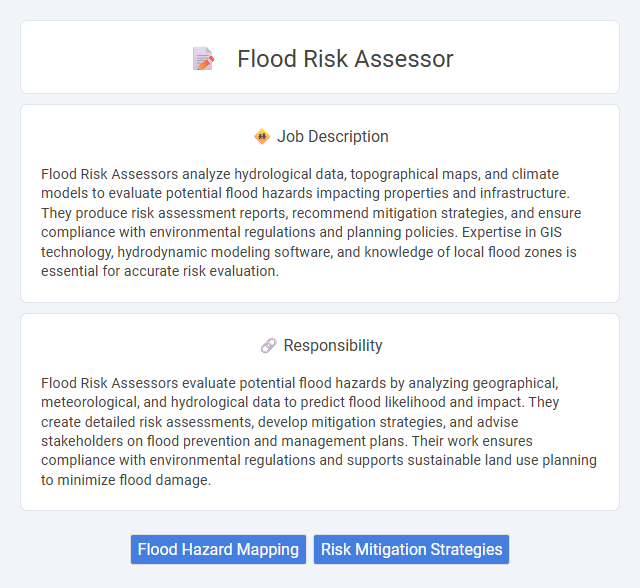
Flood Risk Assessors analyze hydrological data, topographical maps, and climate models to evaluate potential flood hazards impacting properties and infrastructure. They produce risk assessment reports, recommend mitigation strategies, and ensure compliance with environmental regulations and planning policies. Expertise in GIS technology, hydrodynamic modeling software, and knowledge of local flood zones is essential for accurate risk evaluation.
Individuals with strong analytical skills and attention to detail are likely suitable for a Flood Risk Assessor role, as it involves evaluating environmental data and predicting flood probabilities. Those comfortable with technical software and fieldwork may find the job aligns well with their abilities, while people who prefer less data-driven or physical roles might be less suited. Candidates with a background in environmental science or civil engineering probably have a higher likelihood of success in this position.
Qualification
A Flood Risk Assessor typically holds a degree in environmental science, civil engineering, hydrology, or a related field, coupled with specialized training in flood risk management and hydraulic modeling. Proficiency in Geographic Information Systems (GIS), data analysis, and relevant software such as HEC-RAS or Flood Modeller is essential. Strong knowledge of hydrological processes, climate change impacts, and regulatory frameworks related to flood risk assessment enhances the ability to evaluate and mitigate flood hazards effectively.
Responsibility
Flood Risk Assessors evaluate potential flood hazards by analyzing geographical, meteorological, and hydrological data to predict flood likelihood and impact. They create detailed risk assessments, develop mitigation strategies, and advise stakeholders on flood prevention and management plans. Their work ensures compliance with environmental regulations and supports sustainable land use planning to minimize flood damage.
Benefit
Working as a Flood Risk Assessor may provide significant benefits such as enhancing expertise in environmental risk analysis and contributing to community safety through accurate flood prediction. The role likely offers opportunities for career growth within environmental consultancy and insurance sectors due to increasing demand for flood risk management. Moreover, professionals in this field might experience job stability as climate change continues to influence flood frequency and severity.
Challenge
Flood Risk Assessors likely face the challenge of accurately predicting flood events amid changing climate patterns and urban development. The complexity of analyzing diverse data sources, such as hydrological models and land use, increases the probability of encountering uncertainties in risk evaluations. Adapting to evolving regulations and technologies may further complicate the ability to produce reliable flood risk assessments.
Career Advancement
A Flood Risk Assessor evaluates potential flood hazards to develop mitigation strategies, utilizing hydrological and geospatial data analysis. Career advancement opportunities include progressing to senior risk assessor roles, project management positions, or specializing in climate resilience consultancy. Gaining certifications in environmental science and mastering advanced modeling software enhances prospects for leadership roles in environmental risk management firms.
Key Terms
Flood Hazard Mapping
Flood Hazard Mapping is a critical responsibility for a Flood Risk Assessor, involving the analysis and visualization of flood-prone areas using advanced geographic information systems (GIS) and hydrological models. This process enables accurate identification of flood zones, aiding in risk evaluation and the development of mitigation strategies tailored to specific regions. Expertise in interpreting topographic data and historical flood events ensures precise hazard delineation vital for urban planning and infrastructure resilience.
Risk Mitigation Strategies
Flood Risk Assessors develop and implement risk mitigation strategies by analyzing hydrological data, floodplain mapping, and climate models to predict potential flooding scenarios. They design structural measures such as levees, flood barriers, and drainage systems, alongside non-structural approaches including land-use planning, early warning systems, and community education programs. Their expertise enables organizations to reduce flood damage costs and enhance resilience by integrating sustainable flood risk management practices.
 kuljobs.com
kuljobs.com